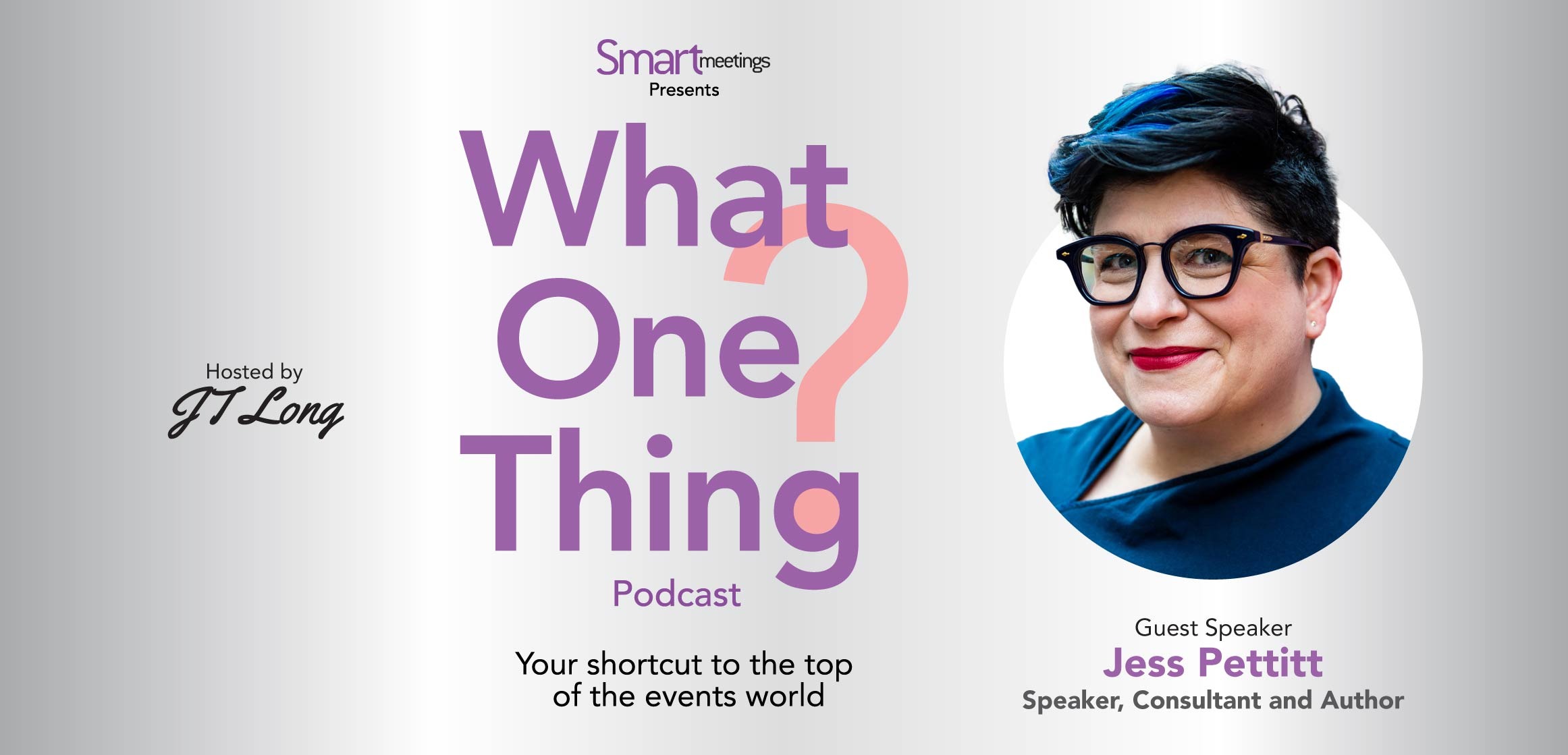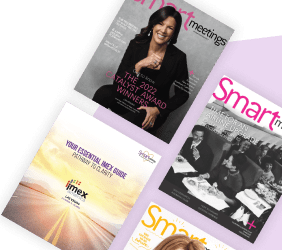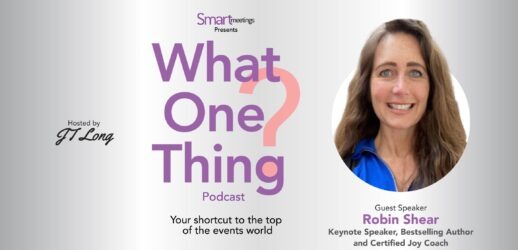How can leaders lean into having meaningful conversations?
In the latest discussion of What One Thing?, Smart Meetings’ JT Long, vice president and content director, chats with Jess Pettitt, a keynote speaker, author and expert on navigating challenging conversations to improve workflow. Pettitt offers some helpful tips to give planners some starting steps in moving their teams toward success.
Editor’s note: This episode of What One Thing? was transcribed by Otter.ai and edited lightly.
JT Long 00:00
Welcome back to What One Thing?, a Smart Meetings podcast that provides a shortcut to the top of the events world by asking successful people what made a difference in their careers and lives.
I’m JT Long, vice president and content director at Smart Meetings, and this conversation could be the start of a whole new life for you. Jess Pettitt is a speaker and author of several books, including Good Enough Now and her new one, Almost Doing Good.
I always appreciate her very direct approach to authentic leadership, and I dedicate this message to anyone who needs to hear it today. Welcome, Jess.
Jess Pettitt 00:45
Oh, thank you so much for your kind words. It’s been lovely working with you over the years.
JL 00:49
Every time I talk to you, I learn something new. So, I’m excited to dive into this conversation. The first thing we want to do is get to know Jess a little bit, so paint us a picture of a young Jess Pettitt. Were you born as colorful beacons speaking the truth? What drove you to become an author and speaker in real-world DEI?
JP 01:13
So that’s like three different questions. I’m going to try to answer all three at once. I grew up in a family of storytellers who used a lot of humor, which basically means no one knows how big Grandpa’s fish was, right?
We just rolled with the stories. Our parents died when we were young, so my brother and I have a rule that if we both remember a story the same way, we’ll just pretend it’s true because we have no idea.
The comedic timing, but also the understanding of community and what happens with storytelling, was a big part of my family. That’s equally paired with curiosity and research. Writing books is kind of my dissertation because I’m the only person in my family who didn’t get a Ph.D. Writing has always been around me, so it’s not surprising at all that I love words.
As far as little baby Jessica—little baby Jessica was a loner who didn’t have a lot of friends. It might have been related to having headgear and braces for almost 10 years, but I had to beat the bullies to the punch.
I was very used to being not the center of attention in a popular way but using the outlier attention in a way that was more comforting for me. As I’ve grown up, that has led me to have fun coloring my hair, and I can wear whatever clothes I want to. That’s often perceived as bravery or confidence, which I always find funny.
I don’t know that I’m brave, and I’m certainly insecure enough to wonder if I’m always confident, but it’s not from a lack of familiarity with being an outlier. That makes a nice sandwich when you start looking at history and doing research. Anybody who made a difference in the world was an outlier with a sense of humor.
So, I just do that. And most people I know use hair dye—I just pick fun colors.
JL 03:25
Listening to that story, it sounds like a big part of it was also building empathy. Do you feel that might be one of your superpowers?
JP 03:38
I didn’t know that question was coming, but it started making me think immediately of my stand-up comedy experience. Most comics are very dark people who use humor to process trauma and stress. That’s true for me, too.
I was lucky enough to use the things I’ve survived—or that others around me have survived—to create spaces where pain can invite healing.
And this might sound “woo-woo,” but I believe you can’t heal by yourself. When you can invite someone into pain, that empathy for the other person’s pain is the bridge to your own healing. I believe that very strongly. Otherwise, I honestly don’t think I’d still be here.
JL 04:47
I wasn’t planning to go down this path either, but I feel like when I hear you speak, you’re not just talking about the scholarly idea of what could happen. You feel, in a deep place, what your audience is going through and struggling with, and you help them find solutions from that very real place. I think that’s what I really appreciate about how you approach audiences.
JP 05:24
Wow. That is such a huge compliment. Thank you.
The language I’d use is that I lower the bar to make things more accessible.
My tagline is: “Do the best you can with what you’ve got, some of the time.”
That may not work for an orthopedic surgeon, but for a diversity specialist, I’m asking you to take action without waiting for perfection—that’s how we got stuck in the first place.
The closer you get to the scholarly ideal, the more performative it becomes because it’s not rooted in truth or care. Truth and care might lead to failure, but at least that failure is in the right direction.
We don’t value that enough. I lower the bar of accessibility instead of teasing people with what’s unlikely to occur.
JL 06:25
Why is that so important? For leaders and meeting professionals, approaching diversity can feel as hard as orthopedic surgery. It’s a struggle to have conversations that matter. There seemed to be an opening where everyone talked about it, then a pushback, whether it’s fatigue or hostility. How can we have important dialogues without making them painful?
Let me know if you’d like this format for the rest of the content or have preferences for line breaks, further summarizing, or specific headings!
JP 07:04
If I can nudge on that a little, I don’t know that you make it less painful—you just prepare and understand that it’s worth it.
I’m not saying I’m a “bruise pusher” or something, but expecting conversations to go perfectly is scarier to me than saying, “I don’t know. Let’s give this a try.”
I also think people have the skills to do difficult things that baffle them. We all have examples of rising to challenges, but we often choose not to use those skills. We’re responsible for those choices, whether we decide to use those skills or not.
You don’t need to use them 100% of the time—sometimes, you just need Netflix and snacks. But when you do choose to use those skills, doing so consciously is a step in the right direction.
JL 08:15
Why is it so tempting to avoid using a skill that could ultimately bring people together?
JP 08:21
Oh, the list is endless: imposter syndrome, perfectionism, anxiety, scarcity, FOMO—there are countless reasons we don’t use the skills we already have.
In my new book, I talk about recognizing a problem you don’t personally experience. It’s about navigating through all those reasons we don’t deploy our skills, often choosing to ignore or deny problems simply because we didn’t experience them ourselves.
For example, I’ve never birthed a child, but I hear it happens, right?
JL 09:10
It’s not easy—I can tell you that.
JP 09:13
I don’t know that firsthand, but I can empathize enough to assume it’s painful, scary, and likely comes with expectations that might not even be clear until years later.
I don’t need to have firsthand experience to acknowledge that something is scary and unknown. Empathy allows me to connect it to my own experiences of fear or uncertainty. Those connections make the skills I already have applicable, even in unfamiliar situations.
JL 10:01
Birthing a child is easier than raising one—that brings its own unexpected challenges. If a planner wants to approach this topic with baby steps, what should they do first?
JP 10:24
I tend to recoil at the idea of a linear model, so I can suggest baby steps, but let’s not call them “Step 1” and “Step 2.” It’s more like “this and this and this.”
In my book, I use the image of a three-person bicycle. All three people are pedaling in the same direction, building momentum. But one person can take a break while the other two carry the load for a while. That’s what I mean by baby steps—they must work in conjunction.
The first seat on the bicycle involves preparation: What do you already do? What do you already know? What have you already experienced?
Meeting planners, for example, are skilled at planning for anything that could possibly go wrong. When something new happens, they adapt their plans for the next event. Recognizing your historical reference points and skills is crucial preparation.
The second seat is about identifying the priorities of your organization, community, or individual. When an emergency happens, what is the priority? Is it education, community building, or something else?
Understanding these priorities helps you make better decisions during emergencies and ensures your response aligns with your organization’s values.
The third seat is recognizing the difference between a habitual reaction and a planned response. A habitual reaction is based on what’s familiar, while a planned response considers your skills, values, and historical context.
This is about aligning your actions with the culture and expectations of your organization. When you know what you stand for, it’s easier to respond effectively.
JL 15:03
I love that analogy of the three-person bicycle. It really is a team effort, and when everyone agrees on priorities, it makes hard decisions easier.
What about when people don’t agree? How does a planner navigate differences and still move forward?
JP 15:34
The trickiest part of navigating differences is avoiding moral relativism.
In any given moment, my life has taught me to show up a certain way, and someone else’s life has taught them to show up differently. That creates space for curiosity.
It’s hard to be anxious, fearful, and curious at the same time.
For example, I was recently at a retreat center known for accommodating food preferences. The new executive director didn’t like the spices in his meal—not due to an allergy but simply preference.
He didn’t want to rock the boat, so he quietly grew more frustrated while the chef rattled off ingredients. They were talking past each other.
I interrupted and reframed the conversation: “This amazing food doesn’t accommodate his specific needs. What if you could eat anything right now—what would you want?”
The chef made exactly what he wanted, and both parties were satisfied.
Both the chef and the executive director were correct in their perspectives, but curiosity and reframing allowed us to address the real issue.
JL 18:29
That brings us back to taking responsibility for how we show up, right?
JP 18:37
Absolutely. If you need dinner but ask questions in a way that prevents you from getting it, that’s on you.
The chef, meanwhile, responded out of habit rather than addressing the cues in front of him. Slowing down and being responsible for who you are and how you’re showing up in a conversation allows you to ask better questions and give better answers.
JL 19:23
Meeting professionals may not always realize the power they have to change things through their decisions. What are some small tweaks planners can make to create a big impact for their audiences?
JP 19:48
This is one of my favorite questions. Let’s take service and support animals as an example.
Depending on the venue or state, different rules apply to what animals are allowed. This creates anxiety because planners don’t want to do the wrong thing.
Here’s an easy solution: Highlight the animal as a part of your event marketing.
For example, introduce Donna’s service dog, Jakarta. Let people know Jakarta’s rules—if she’s wearing a vest, don’t touch her; if not, she loves belly rubs.
Now, if someone is allergic to dogs, they can prepare accordingly. If someone is scared of dogs, learning about Jakarta might ease their fear.
This simple communication solves potential issues before the event even begins.
JL 22:20
It sounds like so much of this comes down to communication—real communication.
JP 22:26
In a lot of ways, yes.
But I also think people hide behind “communication” as an excuse because many of us lack confrontation skills, which makes effective communication hard to achieve.
So, I break it down into two main ideas. First, getting comfortable with disruption. Meeting planners are probably some of the best professionals at this because they’re used to things going wrong. Disruption is inevitable—you might not even know about some of the disruptions happening at your event.
Second, normalizing complexity. We have a bad habit of simplifying problems to the point that we don’t ask enough questions. Can we get comfortable asking, “What else is going on? Who else does this impact? What else does this mean?” By normalizing complexity, you make better plans and decisions.
JL 23:31
There’s so much nuance—it’s not always black and white.
One topic I see addressed more often, and I’m glad about, is accommodating neurodivergence, like autism. What are we getting right, and what are we still missing when it comes to supporting these attendees?
JP 24:02
That’s a big question.
One mistake I see is overgeneralizing—like reading somewhere that the color blue is calming for neurodivergent people and then making everything blue. That’s not a universal solution.
Instead of assuming, ask. Who’s coming to your event? What do they need?
Often, planners include an “accommodations” line on registration forms, but they look at it once, make adjustments, and move on. They might never follow up to see if those accommodations were effective.
For example, someone might request kosher meals. Planners often provide kosher breakfast, lunch, dinner, and snacks—but what if that person doesn’t eat breakfast? You’ve wasted time and money.
Instead, ask: “Are you a morning person? Do you prefer a snack at 10 p.m.?” This conversation could save your budget and ensure attendees feel cared for.
Follow up with attendees after the first day: “How did today go? Was the sound level okay? Were the lights comfortable?” These small touchpoints can make a huge difference.
JL 26:30
I’ve seen that exact scenario play out. You’re so right.
From your new book, Almost Doing Good, what do you hope leaders will take away?
JP 26:42
Leaders are responsible for the culture their stakeholders experience—whether those stakeholders are employees, customers, or even family members.
I work with many founders, and they often don’t realize there’s a gap between what they think is happening and what’s actually happening.
When you start a company in your garage, you know everything that’s going on. But as your organization grows, layers of management prioritize what you need to know, and you can no longer see everything firsthand.
This gap creates blind spots. Shows like Undercover Boss are so popular because they reveal what leaders didn’t know they didn’t know.
It’s important to cultivate curiosity, accept disruption, and normalize the complexity of your own organization. That’s not just a lesson for founders—it applies to meeting planners, leaders, and even friend groups.
JL 28:14
That’s so true. Founders, CEOs, and planners create what’s often called the “overstory”—the tree canopy that shapes the culture of an event or organization. That unspoken culture impacts how everyone behaves and experiences things.
JP 28:48
Exactly. And over time, those behaviors become so normalized that no one remembers why they started.
I once consulted for a sorority where two chapters on the same campus kept sabotaging each other—not physically, but vandalizing cars and houses.
When I investigated, it turned out no one could remember why they didn’t like each other. They just felt responsible for maintaining the animosity.
I asked, “Do you want to spend your energy this way?” Eventually, they realized they didn’t even know why they were fighting.
We did an exercise to list what they hated about the other group. The list was very short.
JL 30:07
That’s so often the case. We believe something simply because we’ve never examined it—it’s been passed down for generations. Sometimes, it’s time to say: no more dead squirrels.
Jess, this has been so fun. But we’re here on What One Thing? to learn the one thing that made the biggest difference in your career and life. What’s your lesson for our community?
JP 30:49
That’s a smart question. My answer is urgency—or rather, learning to manage it.
It took me years to realize that I control my own sense of urgency.
Just because something is urgent for someone else doesn’t mean it has to be urgent for me. I can choose to stop what I’m doing to address it—or not.
When I was growing my speaking business, vendors would tell me I “needed” certain expensive bells and whistles. But I didn’t have the budget. Eventually, I realized those were marketing schemes. I didn’t need those things—they were optional.
The next time something feels urgent, take a breath. Eat a sandwich. When you’re calmer, you’ll make better decisions.
Before you react to someone else’s emergency, make sure you’ve even understood the situation correctly. People often react to the wrong need in an emergency way, which creates even more problems.
Be cool as a cucumber. Look at the resources you already have and what you’ve done before. And then move forward with clarity.
JL 33:15
Jess, once again, you’ve changed my life. First, I’ve learned to have a snack—it’s going to be fine. Second, I’ll try to manage my urgency. Yours isn’t mine, and mine might not be yours. Thank you for that.
JP 33:49
You’re welcome. And here’s a challenge for you—and Eming, your producer, too.
Sometimes, your own sense of urgency isn’t even your own—it’s something you’ve convinced yourself of.
You can coach yourself out of your anxiety. Tell yourself: “This can wait until tomorrow, and it’ll be fine.” Unless it’s a real deadline, of course.
JL 34:38
True—unless it’s a deadline. Eming, remember that deadlines are real emergencies.
JP 34:46
[Laughs.] Exactly. I’m self-employed, so I make my own deadlines. But I can also renegotiate them with myself: “Hey, Boss, this isn’t going to happen. The scope changed, and we need to adjust.”
If I can do that with myself, it’s easier to have that conversation with others.
JL 35:24
I’m so tough on my future self—I’m not very nice to her.
JP 35:29
Same. I’ve been on Zoom since 5 a.m. Someone needs to rein in my boss.
JL 35:35
Jess, thank you so much for spending this time with us. I’ve learned so much, and I know our community will, too. Have a fabulous rest of your week.
JP 35:46
Thank you. And remember, Almost Doing Good means doing the best you can with what you have, some of the time.




